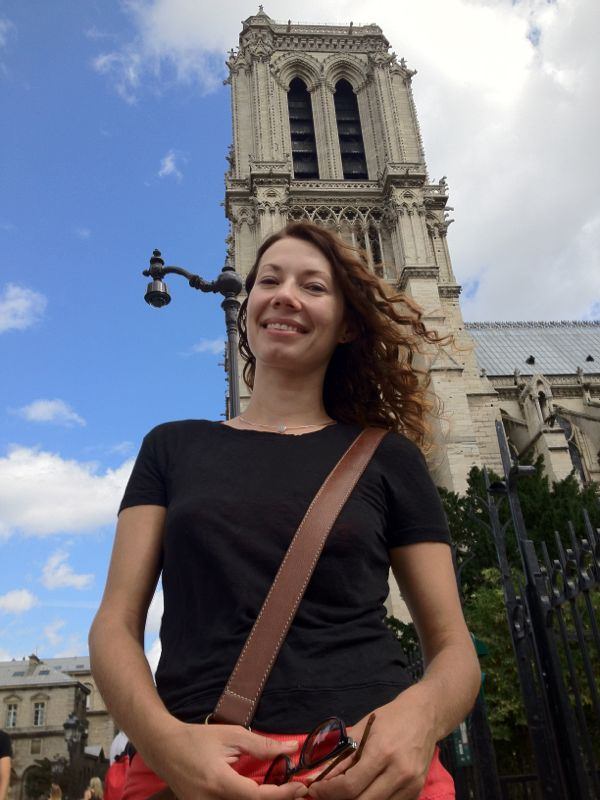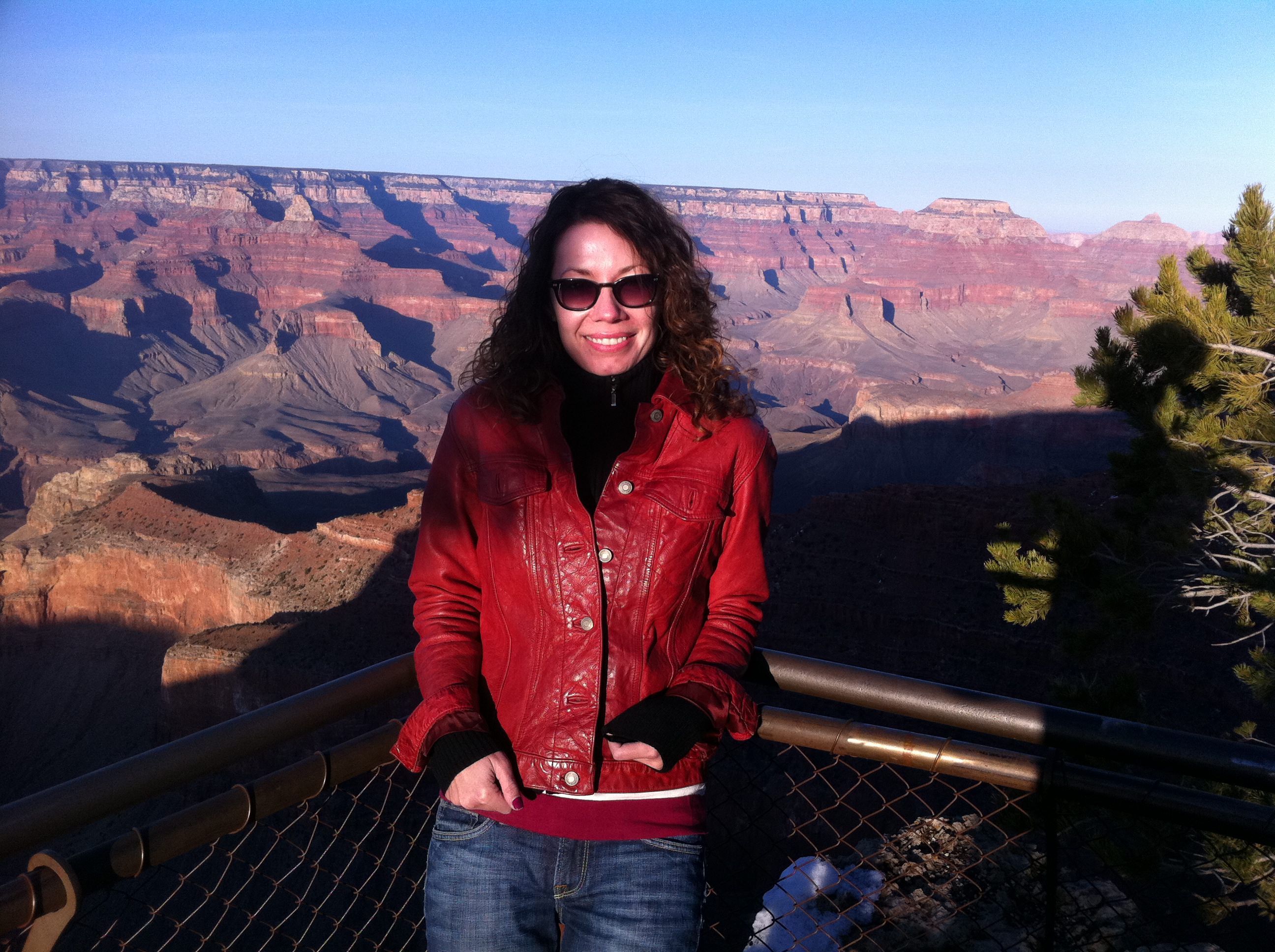If not for biophysics, Crina Nimigean might already be retired from her alternate career path as a ballet dancer. Instead, she chose to follow in the scientific footsteps set out by her role model and grandfather, who worked creating specialty hybrid grapes for winemaking for the Agronomical Institute of Bucharest. “He was incredibly smart and very well-respected in his field,” Nimigean remembered. “He was also able to travel extensively to conferences, which interested me because I always wanted to travel.”
Growing up in Bucharest, Nimigean was not particularly interested in biology or physics. She was a reader and a dreamer—hoping to travel the world, a difficult feat in the former Eastern Bloc countries—interested in foreign languages and spending time outdoors with her friends. With a mathematician mother and an engineer father it was no surprise that she discovered a natural ability for math and physics while she was a young student. Upon completing high school, Nimigean decided to pursue physics at the Faculty of Physics at the University of Bucharest. “In Romania, at that time, one chose early, after high school, what to do for the rest of one’s life,” reflected Nimigean.
A college experience almost singularly focused on math and physics—without much choice—led quickly to burnout for Nimigean. After three years of classes devoted to two subjects, “I was getting a bit bored of physics,” she admitted, “I did not think I could do that for the rest of my life.” So when the time came to specialize, Nimigean chose biophysics and never looked back.
It was exhilarating — I realized that working in a lab could be exciting. I did not sit down at the table because I was hungry; rather the appetite came while I was already eating.
- Nimigean
Her last two years in college were strikingly different from the first three. “We had great theoretical courses, wet labs courses, and young, enthusiastic teachers,” she said. “It was much different from the physics track.” During her final year at the Faculty of Physics, Nimigean won a European Tempus Fellowship to spend three months working on her diploma thesis in a physical chemistry lab at the University of Coimbra in Portugal, one of the oldest continuously active universities in the world. For the first time, Nimigean was able to work by herself in the lab, on her own individual project. “It was exhilarating—I realized that working in a lab could be exciting,” she said. “I did not sit down at the table because I was hungry; rather the appetite came while I was already eating.”
 After completing her diploma thesis in Portugal, Nimigean moved to Karl Magleby’s lab at the University of Miami to work on her PhD. Working in Magleby’s lab launched her into her current area of specialization, the structure and mechanism of ion channels. “I was working on my third rotation in his lab and fell in love with real-time, single-channel recordings that the postdoc who was training me was recording,” she said. “It was fascinating to ‘see’ the work of a single ion channel!”
After completing her diploma thesis in Portugal, Nimigean moved to Karl Magleby’s lab at the University of Miami to work on her PhD. Working in Magleby’s lab launched her into her current area of specialization, the structure and mechanism of ion channels. “I was working on my third rotation in his lab and fell in love with real-time, single-channel recordings that the postdoc who was training me was recording,” she said. “It was fascinating to ‘see’ the work of a single ion channel!”
The benefits of attending the BPS Annual Meetings started early for Nimigean. “I have made a lot of connections at the Biophysical Society meetings,” she said, “The simple fact of going and presenting our science every year helps maintain our research in the eyes of the community.” No more so than in the eyes of Christopher Miller, who met Nimigean at the 1998 Annual Meeting in Kansas City, Missouri. “Crina came up to me at a poster session and asked to discuss the possibility of a postdoc in my lab,” Miller recalls. “But I blew her off, saying that the lab was full, which was true, and that my head was empty of any ideas for new projects—also true.” Nimigean left Miller, but was not deterred. “She returned about an hour later to suggest some new projects, in what I learned was her characteristically insistent manner,” said Miller. Having impressed Miller with her persistence, Nimigean ended up completing her postdoc with him at Brandeis University, working on ion channel permeation processes in KcsA and on a bacterial CNG-binding channel.
“Her persistence in everything is very impressive,” said Miller. “She’s a bulldog who goes after a goal and doesn’t let go, even in the face of disappointment.”
After completing her postdoc, Nimigean earned her first independent position as a PI at the University of California, Davis.
Today, Nimigean remains involved with the Society, having served as the 2011 Chair of the Permeation & Transport Subgroup, and regularly attending the Annual Meetings. “We prepare for the meeting heavily,” she said. “I always felt terrible if I did not have something to present.” The meeting also serves as a social event, “time to catch up with friends and acquaintances and find out what they are up to scientifically,” Nimigean said, adding, “It’s also nice to share our science with them.”
Dirk Gillespie of Rush University Medical Center, and the current Chair of the Permeation & Transport Subgroup, worked with Nimigean for several years organizing Subgroup events at the Annual Meeting. “Crina was instrumental in growing the Subgroup,” Gillespie said. “She helped expand the number of speakers, including adding student and postdoc presentations, and she single-handedly procured the first outside funding for the group.”
 Balancing life outside of science—while still remaining competitive—has been a challenge for Nimigean. “I had to learn to be more efficient if I wanted to do things other than science,” she said. “Constantly applying for grants can be draining, and is an inefficient way to do science.” She currently works as an associate professor at Weill Cornell Medical College, and is learning the difficulties and rewards of managing people. “Understanding how different characters and minds work, and at the same time being mindful of the personal lives of colleagues is not easy,” Nimigean says. Her skill at managing individuals was frequently on display during her tenure as a Subgroup chair. “Crina was really fun and always smiling, but also productive and full of ideas. Her easy-going intensity set the tone for our meetings, having fun while maintaining focus and making progress,” said Gillespie. “Her thoughtfulness and preparedness is something I am currently trying to emulate in my tenure as chair.”
Balancing life outside of science—while still remaining competitive—has been a challenge for Nimigean. “I had to learn to be more efficient if I wanted to do things other than science,” she said. “Constantly applying for grants can be draining, and is an inefficient way to do science.” She currently works as an associate professor at Weill Cornell Medical College, and is learning the difficulties and rewards of managing people. “Understanding how different characters and minds work, and at the same time being mindful of the personal lives of colleagues is not easy,” Nimigean says. Her skill at managing individuals was frequently on display during her tenure as a Subgroup chair. “Crina was really fun and always smiling, but also productive and full of ideas. Her easy-going intensity set the tone for our meetings, having fun while maintaining focus and making progress,” said Gillespie. “Her thoughtfulness and preparedness is something I am currently trying to emulate in my tenure as chair.”
Despite these challenges, the exhilaration of lab work has not left her. “I want to do this forever,” she confesses. Nimigean hopes to continue to operate her own small lab, working with a few colleagues to understand how proteins work at the molecular level.
When not applying for grants, helping her colleagues, and participating in Biophysical Society activities, Nimigean likes to travel, read, and run. Her key advice for young biophysicists? “Science should be fun!” she says. “Like hanging out with friends—do your science and then go out and enjoy life with your friends and colleagues—talk about science and non-science!”